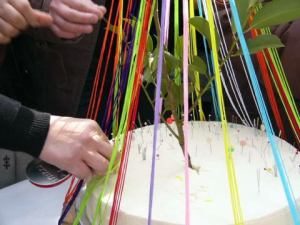I am SO not an expert finisher. I didn't do well in Home Economics with sewing and I do not own a sewing machine (instrument of terror!), so I've had to learn how to do simple finishing myself.
This link will give you a great tutorial for finishing your Christmas ornaments (or scissor fobs or whatever) for a nice look! You simply stitch a simple back stitch around your design and on a matching piece of cross stitch fabric (nice place to put another quick holiday motif or your initials and date or a monogram for the person you're giving it to!). In fact, they even add beads for a really decorative finish! http://www.funkandweber.com/cross-stitch-finishing-overcast-backstitches/
You might try to incorporate a Four-Sided Stitch in place of that simple backstitch on both pieces of fabric for a more decorative finish! You simply fold the excess fabric at the outer edge of your four-sided stitch on each fabric piece .. pinch those two edges together .. and lace the stitches! Like this (scroll down about halfway the page, just under the different stitch illustrations):
http://www.keepsakestitches.com/PDF/Gallery_of_Stitches.pdf
Here's an example of one of Fern Ridge Collection's designs finished that way with a corded hanger added.
And for adding a corded trim .. with my favorite tool the Spinster Cording Drill, you might try this finishing technique (scroll down a bit to see the trim addition): http://stacybinnj.wordpress.com/basic-no-glue-ornament-finishing-tutorial/
On the above ornament .. the cording was inserted through the ornament and then the lacing stitch on the Four-Sided Stitch was completed.
The same 'stitching technique' for adhering the cord to the ornament would work for adding the cool hand-dyed Chenille and Rick Rack trims that our R&R and FromThe Cauldron companies offer!!
Joy to the World
4 days ago





